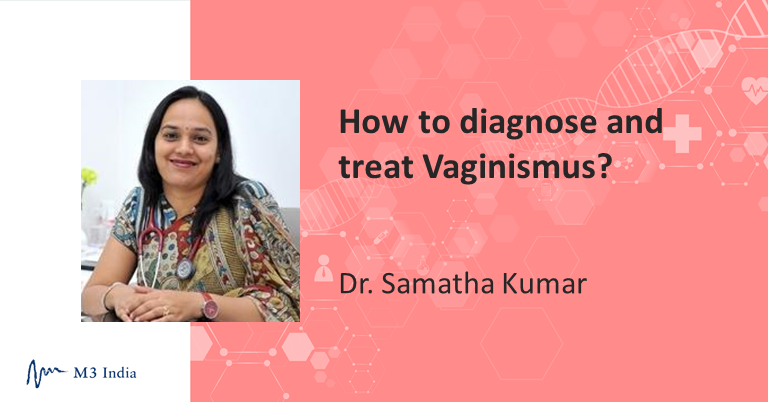How to diagnose and treat Vaginismus? Dr. Samatha Kumar
M3 India Newsdesk Jul 14, 2019
Summary
Dr. Samatha Kumar advises that vaginismus, the sexual pain disorder requires detailed history taking and a wholesome treatment approach for the patient, one that addresses fear, pain, and pelvic floor muscle tension, and these issues should be handled by a multidisciplinary team.

The Diagnostic and Statistical Manual of Mental Disorders, fourth edition (DSM-IV) categorises vaginismus as a sexual pain disorder along with dyspareunia. It describes vaginismus as occuring when 'recurrent or persistent involuntary spasm of the musculature of the outer third of the vagina, which interfere with coitus and causes distress and interpersonal difficulty.' It causes women to have fear, anxiety and pain with penetration attempts.
Vaginismus can be categorised as,
- primary- in which the patient has never experienced non-painful intercourse
- secondary- in which the patient has previously experienced non-painful intercourse but subsequently experiences pain
The prevalence rate of vaginismus in a clinical setting has been estimated as 5 to 17% and it is believed to be one of the more prevalent female sexual dysfunction disorders.
Symptoms and aetiology of Vaginismus
Fear, anxiety and pain of vaginal penetration during sex or PAP test or inability to use a tampon are common indicators.
- Different psychological factors have been associated with vaginismus such as traumatic sexual experiences, sexual abuse, lack of sex education. It frequently leads to marital problems and depression.
- Organic pathologies and pelvic floor dysfunction have been implicated in the development of vaginismus.
How to diagnose Vaginismus?
- Detailed description of the symptoms should be asked during consultation.
- Pelvic examination should be performed to rule out other possible causes of pain.
- If no pathology is found, and the patient complains that she feels pain only during penetration, then it is likely to be vaginismus.
Note: A condition called vulval vestibulitis can be confused with vaginismus, since the information is often not noticed until penetration is tried.
Treatment of Vaginismus
The ideal treatment for Vaginismus must access the complex interplay between the biological, emotional, psychological, and relational components of the woman's and the couples' lives.
Psychological Therapies
- In individual therapy the treatment is to identify and dissolve underlying psychological problems that could be causing the disorder.
- In couples therapy, Vaginismus is conceptualised as a problem for the couple and the treatment tends to focus on the couple’s sexual history and any other problems accruing in the relationship. Detailed information about relevant human anatomy (structure) and physiology (functioninum) is provided to the couple.
- The aim of psychological therapy is provide empathic, supportive clinician-patient relationship to reduce or eliminate performance anxiety and fear of penetration and help gain sexual confidence
Pelvic floor physiotherapy
It aids in developing awareness and control of the vaginal musculature as well as restore function, improves mobility, relieves pain, and overcomes vaginal penetration anxiety.
Vaginal dilators
Vaginal dilators also known as retainers are devices available in kits that include a range of different size dilators. This allows the patients to use the appropriate size with gradual progression throughout the treatment. These dilators help in overcoming the fears and anxiety associated with vaginal penetration. They aid in the recovery and rehabilitation of the pelvic floor musculature and vaginal tissue from stretching and tightness.
A wholesome treatment approach for vaginismus addressing fear, pain, and pelvic floor muscle tension is recommended which should be addressed by a multidisciplinary team.
Disclaimer- The views and opinions expressed in this article are those of the author's and do not necessarily reflect the official policy or position of M3 India.
The author, Dr. Samatha Kumar is a Gynaecologist from Hyderabad.
This article was originally published on 22.04.19
-
Exclusive Write-ups & Webinars by KOLs
-
Daily Quiz by specialty
-
Paid Market Research Surveys
-
Case discussions, News & Journals' summaries